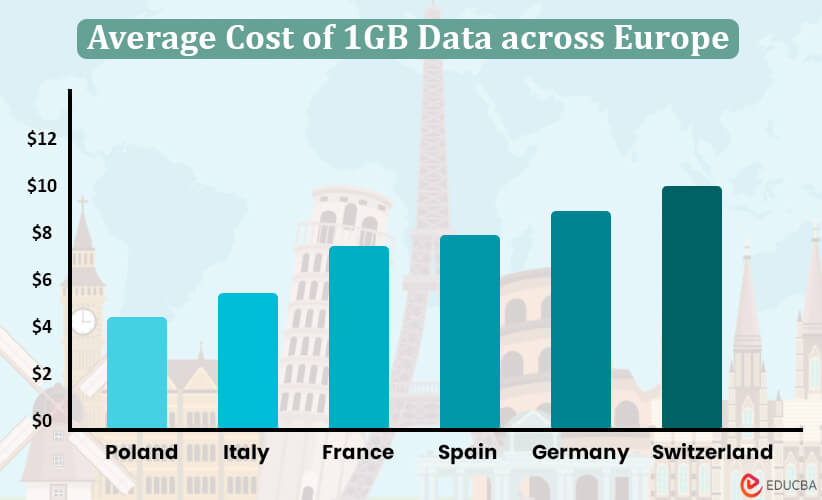Tips for Exploring Europe with Technology
Europe’s iconic cities, stunning landscapes, and rich history attract travelers from around the world. But when you are navigating around this diverse continent, you might face some technology challenges, like searching WiFi for unfamiliar (foreign) SIM cards. Thus, this article will guide you with expert tips to help you make the most of your devices while exploring the endless beauty of Europe.

#1: Download Must-Have Public Transport Apps
When you are exploring Europe’s metropolitan hubs, it is necessary to have public transportation apps. Paris’s RATP and London’s Tube Map are great must-download apps. They provide access to subway maps and real-time route planning without an internet connection. According to Statista, as of 2021, the Moovit app was Europe’s most popular public transit app, with over 100 million downloads.
These navigation apps make it easy to get around urban cities, especially with limited WiFi access. Download these apps before your trip to avoid roaming charges and ease navigation in unfamiliar cities.
#2: Navigate Free WiFi Wherever Possible
Around 90% of Europeans have internet access at home. However, free WiFi in public places can have some rules. Sometimes, it requires registration, or there might be usage limitations. One tip is to create temporary accounts for accessing free WiFi when necessary. Also, turn the WiFi off when you are not using it to avoid automatic connections that will drain your data.
If you are visiting a place for a short duration, free WiFi in cafes and public hotspots works fine. But investing in a local SIM card will be smarter if you stay longer or travel between countries. Relying only on free WiFi is risky, and you might struggle using maps or other useful apps.
#3: Create Smart Charging Solutions
Running out of battery is a common problem when you are traveling. According to a Washington Post survey, 37% of travelers have experienced charging issues. So, looking at this matter and creating resourceful solutions is important.
You can use USB ports available in hotels, cafes, airports, and trains. You should also carry a portable charger or multi-port USB adapter to maximize charging opportunities. If you forget the plug adapter, you can use laptops, DVD players, game consoles, and even in-flight entertainment systems to charge.
You can use binder clips to keep charging cables in place if the outlet has no faceplate or wrap the cord around a pen or pencil to avoid damage when plugging into a loose port. Ensure to charge your phone with a portable solar panel while sightseeing for an eco-friendly charge. Also, attach an external battery pack to your backpack strap for easy access to extra power and even consider a charging case, wallet, or purse designed to charge your phone on the go.
#4: Master Offline Maps
For tech-savvy travelers who want to save on data, mastering offline maps is key to navigating without roaming charges. Use Google Maps to download destinations in advance using WiFi and save specific map areas for later or entire cities. Apple Maps also works offline via GPS, letting you find addresses and businesses without a connection.
Moreover, apps like “MAPS.ME”, “HERE WeGo”, and “Navmii” provide turn-by-turn walking directions without using mobile data. Download the maps you need for each country ahead of time and take screenshots of maps for easy reference. As a backup, sync your itineraries (travel plans) across different devices, share your location on Google Maps with companions, and use the GPS dots to track your real-time position on offline maps.
With these handy offline map preparations, you can navigate seamlessly while worrying about data overages during your travels.
Best SIM Card Solutions for Traveling Across Multiple Countries
(Data Source: Cable.co.uk)
Data-only SIM cards are a great choice for staying connected while exploring Europe with technology. Some providers offer plans covering 42 countries, like “1GB for 30 days at $23” to “25GB for $187”. Meanwhile, the Holafly data plan for Europe offers unlimited data with a stable and fast connection, and you can choose to subscribe between 5 to 90 days, depending on your trip duration.
Other providers offer plans that cover 45 European nations with 1GB for 30 days starting around $42. Their Europe Data SIM card simplifies roaming with one number for calls, texts, and data. So, to avoid expensive roaming fees, invest in a multi-country SIM card.
How Do You Deal with Limited WiFi on European Trains?
WiFi connection in intercity and high-speed depends on the city and provider. You should not expect a constant internet connection when traveling by train across Europe.
Instead, prepare by downloading movies, ebooks, and playlists in advance to keep yourself entertained offline. Bring headphones with a 3.5mm splitter so you and your companions can watch and enjoy together. To save data, consider packing old-school diversions such as books, crossword puzzles, or a deck of cards. It is a good idea for a train ride without relying much on the internet and WiFi.
How Do You Use a Smartphone for Navigation and Information?
Your smartphone is a handy tool when traveling. It can translate foreign languages to your language and can even access maps offline. You can try using Google Translate’s offline mode to communicate when WiFi is unavailable. Save a screenshot of maps, tickets, and directions to access them without using data.
Turn on or activate airplane mode while enabling WiFi to minimize background data usage. Enable location services for GPS navigation without needing data. Therefore, your phone remains an invaluable travel companion even with limited connectivity.
Smart Battery Tips for Exploring Europe with Technology
Use the tips below to save battery and avoid dying your phone mid-trip.
- Turn off Bluetooth and background apps.
- Lower your screen brightness and turn off vibration mode.
- Close apps that you are not using
- Enable power saving mode if your phone battery is running low.
- Carry an external battery pack with at least 10,000 mAh capacity.
Lastly, ensure your device is charged and prepared for any situation during European travels.
Frequently Asked Questions (FAQs)
Q1. How can I save data while traveling across European countries?
Answer: Use offline maps, turn off automatic connections, and use apps selectively with WiFi enabled. Download content in advance, and consider a multi-country SIM card.
Q2. How can I keep devices charged if I forget my travel adapter?
Answer: Make use of USB ports in public places, charge your devices using cables connected to other devices, and carry a portable charger that doesn’t need an outlet.
Q3. What should I know about using WiFi on trains and hotels across Europe?
Answer: Since WiFi quality can vary, it’s essential to have offline entertainment options. Only register and connect to WiFi when necessary, as automatic connections can drain data quickly.
Recommended Articles
We hope this article on exploring Europe with technology was informative and beneficial. For more such articles, refer to the articles below.

